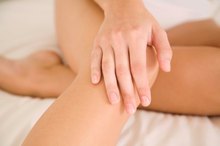What does fact checked mean?
At Healthfully, we strive to deliver objective content that is accurate and up-to-date. Our team periodically reviews articles in order to ensure content quality. The sources cited below consist of evidence from peer-reviewed journals, prominent medical organizations, academic associations, and government data.
The information contained on this site is for informational purposes only, and should not be used as a substitute for the advice of a professional health care provider. Please check with the appropriate physician regarding health questions and concerns. Although we strive to deliver accurate and up-to-date information, no guarantee to that effect is made.
Fitness Tips After a Hip Replacement
Staying fit after undergoing a hip replacement is particularly important since excess weight and a sedentary lifestyle contribute to more pain and make it difficult for you to regain and retain your range of motion after surgery. While you may not be able to engage in all of the activities you did before your hip replacement, as soon as your doctor allows there are many ways to safely improve your fitness level 2.
If you are experiencing serious medical symptoms, seek emergency treatment immediately.
Aerobic Exercise
Aerobic exercise gets your heart rate up and helps you stay fit by burning calories and engaging your muscles. After a hip replacement, certain aerobic activities, such as:
- high-impact aerobics
- running
- or sports that require a lot of jumping
- put too much stress on the joint leading to pain
- injury 2
Low-impact exercise, such as walking, riding a bicycle and swimming helps you get the cardiovascular workouts your body needs to stay fit and healthy without putting excessive pressure on your hip.
Strengthening
Scoliosis Exercises to Lose Belly Fat
Learn More
Strengthening exercises help build muscle tissue to help you stay fit and lean. Exercises that strengthen your hips, thighs and core muscles are particularly important following hip replacement surgery. Using resistance bands while moving your leg to the side and forward and back helps strengthen your hip flexors. Working out with weights, machines, bands or performing other strengthening exercises for the other muscles in your body contributes to a fit body by increasing muscle mass, which burns calories to help trim excess fat.
- Strengthening exercises help build muscle tissue to help you stay fit and lean.
- Working out with weights, machines, bands or performing other strengthening exercises for the other muscles in your body contributes to a fit body by increasing muscle mass, which burns calories to help trim excess fat.
Stretching
Gentle stretching improves your flexibility and range of motion. While stretching all of your body's major muscle groups is important, it is particularly vital to pay attention to your hip muscles after a hip replacement. Many people who undergo hip replacement surgery suffer from hip bursitis, a condition that causes swelling and pain from the fluid sacs around your hip joint 4. Stretching after your warm up and cool down when engaging in aerobic exercise prevents your muscles from tightening after exercise, which can lead to hip pain.
- Gentle stretching improves your flexibility and range of motion.
- Stretching after your warm up and cool down when engaging in aerobic exercise prevents your muscles from tightening after exercise, which can lead to hip pain.
Considerations
How Do I Treat a Bone Chip?
Learn More
Talk to your doctor before exercising after having hip replacement surgery 1. Most patients start light strengthening and range of motion exercises while still in the hospital, but doing too much too fast can lead to severe injury. Be mindful of your condition when exercising. While it's important to maintain a healthy weight after surgery, you shouldn't exercise to the point of pain. Always wear cushioned shoes that support your arches when walking or engaging in other low-impact exercise to absorb the shock and take the pressure off your hip.
- Talk to your doctor before exercising after having hip replacement surgery 1.
- Always wear cushioned shoes that support your arches when walking or engaging in other low-impact exercise to absorb the shock and take the pressure off your hip.
Related Articles
References
- Your Orthopaedic Connection: Total Hip Replacement Exercise Guide
- Your Orthopaedic Connection: Activities After Hip Replacement
- MedlinePlus: Hip Stretch
- Drugs.com: Hip Bursitis
- American Academy of Orthopaedic Surgeons. Total Joint Replacement. Updated June 2014.
- Loeser RF, Goldring SR, Scanzello CR, Goldring MB. Osteoarthritis: A disease of the joint as an organ. Arthritis Rheum. 2012;64(6):1697-1707. doi:10.1002/art.34453
- American Academy of Orthopaedic Surgeons. Hip Osteoarthritis. 2019.
- Bayliss LE, Culliford D, Monk AP, et al. The effect of patient age at intervention on risk of implant revision after total replacement of the hip or knee: a population-based cohort study. Lancet. 2017;389(10077):1424-1430. doi:10.1016/S0140-6736(17)30059-4
- Boniello AJ, Simon MS, Emenari CC, Courtney PM. Complications and Mortality Following Total Hip Arthroplasty in the Octogenarians: An Analysis of a National Database. J Arthroplasty. 2018;33(7S):S167-S171. doi:10.1016/j.arth.2017.08.030
- Bannuru RR, Osani MC, Vaysbrot EE, et al. OARSI guidelines for the non-surgical management of knee, hip, and polyarticular osteoarthritis. Osteoarthr Cartil. 2019;27(11):1578-1589. doi:10.1016/j.joca.2019.06.011
- Evans JT, Evans JP, Walker RW, Blom AW, Whitehouse MR, Sayers A. How long does a hip replacement last? A systematic review and meta-analysis of case series and national registry reports with more than 15 years of follow-up. Lancet. 2019;393(10172):647-654. doi:10.1016/S0140-6736(18)31665-9
- Hu CY, Yoon TR. Recent updates for biomaterials used in total hip arthroplasty. Biomater Res. 2018;22:33. doi:10.1186/s40824-018-0144-8
- American Academy of Orthopaedic Surgeons. Total Hip Replacement. Updated August 2015.
- Zhang X, Shi G, Sun X, Zheng W, Lin X, Chen G. Factors influencing the outcomes of artificial hip replacements. Cells Tissues Organs (Print). 2018;206(4-5):254-262. doi:10.1159/000500518
Writer Bio
Amanda Knaebel is a self-professed gadget geek and loves all things tech, both new and old. Amanda has been working as a freelance writer for over 10 years on topics including technology, health, fitness, nutrition, gardening and many more. She has also worked with Fortune 50 tech and financial companies, both in technical support and content production.









